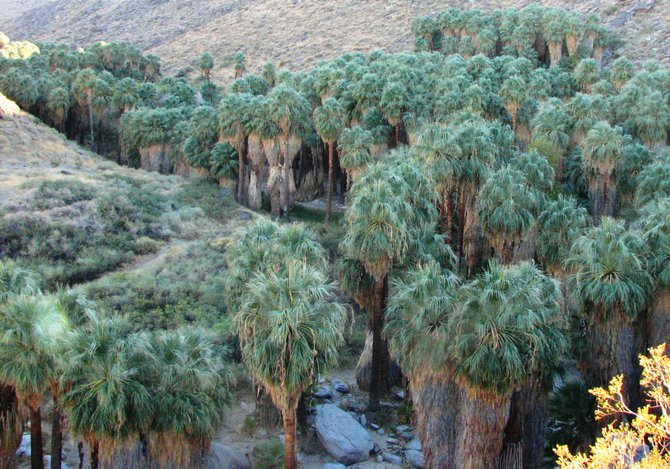 Facebook
Facebook
 X
X
 Instagram
Instagram
 TikTok
TikTok
 Youtube
Youtube

Having seen two of the palm groves at the Anza-Borrego Desert State Park, I was inspired to drive north towards Palm Springs to see the largest palm groves in the world at the Agua Caliente Indian Reservation.
A $9 entrance fee paid at the toll booth on South Palm Canyon Drive grants you access to three of the four canyons on the reservation. Palm Canyon, one of three “Indian Canyons” on the reservation in Palm Springs (open daily October to July, 8:00 a.m. to 5:00 p.m.), is the largest oasis of fan palms anywhere in the world.
Behind the trading post, fifteen miles of hiking trails wind beneath the palm canopy set deep in a canyon along the ancient riverbed where traces remain of the ancestral Cahullia Indians. It is a stunningly beautiful, deeply peaceful place, a forest of 60-foot fan palms with occasional glimpses of majestic snow-capped San Jacinto between the fronds. Picnic tables were set under the lush canopy among traditional shelters made of dried palm fronds. I had seen nothing like it in my life, and so was duly impressed.
Another hiker told me that there’s access from the San Jacinto Mountain road above the reservation into the canyon, for those who care to walk the entire length in a day.
The smaller Andreas Palm Canyon was not nearly as impressive, although it too shades a perennial creek. A trail links it with Murray Canyon, private habitat to the endangered Peninsular Bighorn Sheep and secluded nesting spot for the endangered Least Bell’s Vireo.
Tahquitz Canyon, with its petroglyphs and seasonal 60-foot waterfall, is accessible from the Tahquitz Canyon Visitor Center off West Mesquite for a $12.50 admission fee. Its steep, rocky two-mile round trip trail is open October to July, 7:30 a.m. to 5:00 p.m. daily. Unlike the other canyons, this one is not shaded by a thick palm grove.
Leaving Indian Canyon at sunset afforded a wonderful view of the massive windmill farm just north of Route 10 in the foothills of the Sierra Nevadas. Although I was planning to spend a few hours in historic Palm Springs, the post-Veteran’s Day Parade traffic thwarted that plan, as the downtown district was inaccessible and looked as though it would be for hours.
Instead, I drove back west, towards the coast. Given its close proximity, I’ll be back to Palm Springs when things are calmer to explore the historic art deco town.


Having seen two of the palm groves at the Anza-Borrego Desert State Park, I was inspired to drive north towards Palm Springs to see the largest palm groves in the world at the Agua Caliente Indian Reservation.
A $9 entrance fee paid at the toll booth on South Palm Canyon Drive grants you access to three of the four canyons on the reservation. Palm Canyon, one of three “Indian Canyons” on the reservation in Palm Springs (open daily October to July, 8:00 a.m. to 5:00 p.m.), is the largest oasis of fan palms anywhere in the world.
Behind the trading post, fifteen miles of hiking trails wind beneath the palm canopy set deep in a canyon along the ancient riverbed where traces remain of the ancestral Cahullia Indians. It is a stunningly beautiful, deeply peaceful place, a forest of 60-foot fan palms with occasional glimpses of majestic snow-capped San Jacinto between the fronds. Picnic tables were set under the lush canopy among traditional shelters made of dried palm fronds. I had seen nothing like it in my life, and so was duly impressed.
Another hiker told me that there’s access from the San Jacinto Mountain road above the reservation into the canyon, for those who care to walk the entire length in a day.
The smaller Andreas Palm Canyon was not nearly as impressive, although it too shades a perennial creek. A trail links it with Murray Canyon, private habitat to the endangered Peninsular Bighorn Sheep and secluded nesting spot for the endangered Least Bell’s Vireo.
Tahquitz Canyon, with its petroglyphs and seasonal 60-foot waterfall, is accessible from the Tahquitz Canyon Visitor Center off West Mesquite for a $12.50 admission fee. Its steep, rocky two-mile round trip trail is open October to July, 7:30 a.m. to 5:00 p.m. daily. Unlike the other canyons, this one is not shaded by a thick palm grove.
Leaving Indian Canyon at sunset afforded a wonderful view of the massive windmill farm just north of Route 10 in the foothills of the Sierra Nevadas. Although I was planning to spend a few hours in historic Palm Springs, the post-Veteran’s Day Parade traffic thwarted that plan, as the downtown district was inaccessible and looked as though it would be for hours.
Instead, I drove back west, towards the coast. Given its close proximity, I’ll be back to Palm Springs when things are calmer to explore the historic art deco town.
Comments